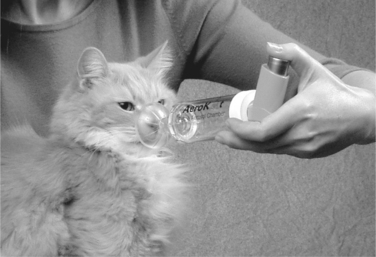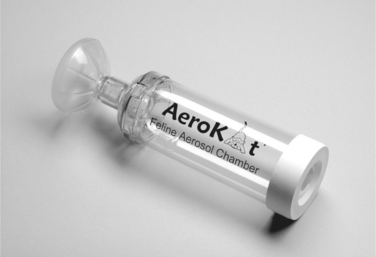I
Inhalant Medication Administration
OVERVIEW AND GOAL
To deliver medication to the respiratory tract with maximal efficacy and minimal side effects
INDICATIONS
Any disease of the respiratory tract for which oral or injectable bronchodilators are indicated:
PREPARATION: IMPORTANT CHECKPOINTS
• Approximately 90% of dogs and 65% of all cats will tolerate the placement of the mask and spacer apparatus the very first time.
• Animals that will not tolerate this device initially still can be trained to acceptance. This usually takes a few days to a few weeks.
POSSIBLE COMPLICATIONS AND COMMON ERRORS TO AVOID
• Mild conjunctivitis occasionally occurs if the top of the mask is in contact with the lower conjunctival lid margins.
• “Thrush,” a yeast infection within the posterior pharynx, is a frequent complication in humans. This has not been reported in dogs or cats using inhaled corticosteroids.
• Growth retardation is a potential concern in children using inhaled corticosteroids. This has not been reported in dogs and cats.
• Cats with respiratory distress due to bronchoconstriction will very quickly benefit from inhalation of bronchodilator drugs. The temporary restraint required to administer these drugs has not been reported to result in clinically significant complications in this setting.
• Some cats will hold their breath. If this occurs, it is essential to wait until the animal begins breathing for 7-10 breaths.
• Some dogs and cats have nasal congestion that prevents inhalation by this method. In these cases, it is useful to instill a drop of a topical nasal decongestant (e.g., phenylephrine drops [Neo-Synephrine]) into either or both nostrils and wait 10-15 minutes before using the inhaled medications.
PROCEDURE
• Place the mask over the animal’s nose (cats) or muzzle (dog). If right-handed, use left hand to place mask.
ALTERNATIVES AND THEIR RELATIVE MERITS
• Nebulization does not offer superior drug-delivery results compared to the simple mask/spacer combination.
• Oral prednisone/prednisolone should be considered when the animal requires immediate antiinflammatory treatment. Inhaled corticosteroids may take 7-10 days to reach full effect. In these cases, prednisone/prednisolone should be administered for the first week concomitantly with the inhaled corticosteroid.
• Parenteral bronchodilators can be used (e.g., terbutaline, subcutaneously [SQ]) if an animal is fractious and cannot be easily restrained.
• Topical medications: no current or prior objective data that document the effectiveness of transcutaneously-administered corticosteroids or bronchodilators in the treatment of respiratory disorders in dogs or cats.
• Alternative therapies: many unproven alternative, evolving, and experimental approaches to treating respiratory disease in the canine and feline species.
 INHALANT MEDICATION ADMINISTRATION Spacer connected to a metered dose inhaler (MDI) and a self-sealing mask of the type commonly used for induction of anesthesia. Spacer acts as a reservoir for inhaled medication, so animal breathes the drug into its airways whenever it breathes through the face mask.
INHALANT MEDICATION ADMINISTRATION Spacer connected to a metered dose inhaler (MDI) and a self-sealing mask of the type commonly used for induction of anesthesia. Spacer acts as a reservoir for inhaled medication, so animal breathes the drug into its airways whenever it breathes through the face mask.Intraosseous Catheter Placement
OVERVIEW AND GOALS
• Insertion and maintenance of a patent catheter in the marrow cavity of a long bone for purposes of administering parenteral fluids, drugs, blood, or virtually any other agent that is routinely given IV.
INDICATIONS
• Urgent fluid replacement in a severely dehydrated/hypovolemic kitten or puppy (most common indication)
EQUIPMENT, ANESTHESIA
• Bandage material: roll gauze, cast padding, stretch and release bandage (e.g., Vetrap), white medical tape
Stay updated, free articles. Join our Telegram channel

Full access? Get Clinical Tree



